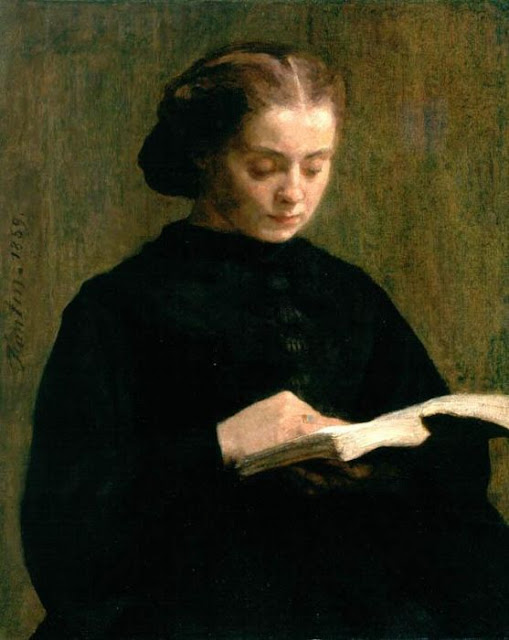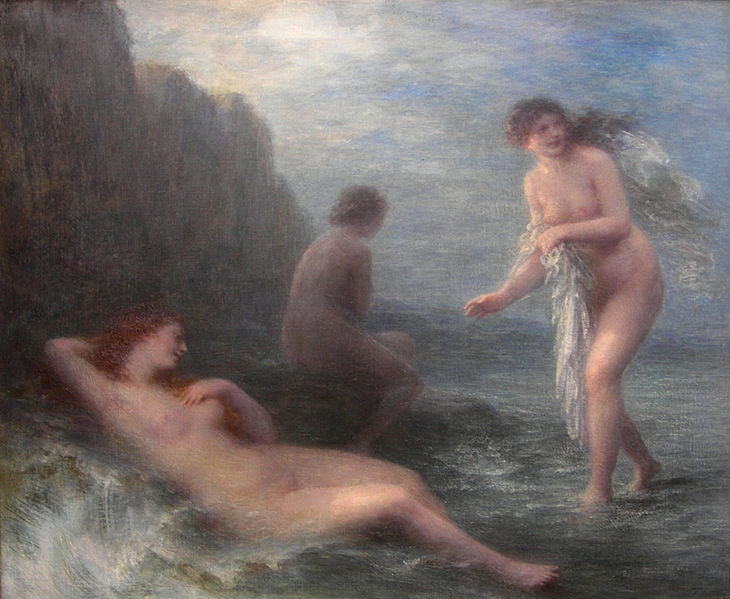French Painters: Henri FANTIN-LATOUR
Henri Fantin-Latour (14 January 1836 – 25 August 1904) was a French painter and lithographer best known for his flower paintings and group portraits of Parisian artists and writers.*He was born Ignace Henri Jean Théodore Fantin-Latour in Grenoble, Isère. As a youth, he received drawing lessons from his father, who was an artist. In 1850 he entered the Ecole de Dessin, where he studied with Lecoq de Boisbaudran. After studying at the École des Beaux-Arts in Paris from 1854, he devoted much time to copying the works of the old masters in the Louvre. Although Fantin-Latour befriended several of the young artists who would later be associated with Impressionism, including Whistler and Manet, Fantin's own work remained conservative in style.Whistler brought attention to Fantin in England, where his still-lifes sold so well that they were "practically unknown in France during his lifetime". In addition to his realistic paintings, Fantin-Latour created imaginative lithographs inspired by the music of some of the great classical composers.In 1875, Henri Fantin-Latour married a fellow painter, Victoria Dubourg, after which he spent his summers on the country estate of his wife's family at Buré, Orne in Basse-Normandie, where he died of lyme disease. He was interred in the Cimetière du Montparnasse, Paris, France.Marcel Proust mentions Fantin-Latour's work in In Search of Lost Time: Many young women's hands would be incapable of doing what I see there,' said the Prince, pointing to Mme de Villeparisis's unfinished watercolours. And he has asked her whether she had seen the flower painting by Fantin-Latour which had recently been exhibited. (The Guermantes Way).His first major UK gallery exhibition in 40 years takes place at the Bowes Museum in April 2011.-1854-Le Songe*-1859-The Two Sisters-1862-Narcissus and Tulips*Diverse Flowers*Flowers and Fruits on a Table*A Carafe of Wine and Plate of Fruit on a White Tablecloth*Flowers and Fruit, a Melon*White Roses and Cherries-1867-Portrait of Edouard Manet*Madame Ditte*Duchesse de FitzJames*Mademoiselle de FitzJames*Marie Yolande de FitzJames*-1868-Asters and Fruit on a Table*-1869-Still Life*-1870-La Lecture*A Studio on the Batignolles*Head of a Young Girl*-1872-The Corner of the TableLilacs-1874-Fleurs et Objets DiversFairy Roses-1878-Homage to BerliozBouquet of Peonies*Vase of Peonies and Snowballs*-1879-La Leçon de Dessin*Summer Flowers*-1881-Gladiolas and Roses-1882-Charlotte DubourgFlowers*-1883-Poppies*Roses*Roses Marechal Neil*-1884-Japanese Anemones*Bouquet of Peonies and Iris*-1885-Autour du Piano*-1888-L'Or du Rhin*Bouquet of Roses and Other Flowers*A Basket of Roses*Anemones and Buttercups*Hollyhocks-1902-Vase of Peonies*
-1903-
Bathsheba
*
-Undated-La Lecture
*Basket of Dahlias
*Nasturtiums
*The Birth of Christ
*The Damnation of Faust
*The Temptation of St Anthony
*Morning
*Night
*La Source
*
Biographie en Français :Ignace Henri Jean Théodore Fantin-Latour, né à Grenoble le 14 janvier 1836 et mort à Buré le 25 août 1904, est un peintre réaliste et intimiste, et lithographe français.Né à Grenoble, il étudie avec son père Théodore Fantin-Latour (1805-1872), artiste, puis avec Horace Lecoq de Boisbaudran à la Petite École de dessin de Paris. Il entre à l'École des beaux-arts en 1854 et participe à l'éphémère expérience de Gustave Courbet en 1859. Il épouse la peintre Victoria Dubourg en 1876. Il passe ensuite ses étés dans la résidence de la famille de sa femme à Buré en Basse-Normandie.Membre du groupe dit « de 1863 », puis du Cénacle des Batignolles d'où surgira l'Impressionnisme, il est un peu, remarquait Gustave Kahn, le chaînon qui unit les peintres d'aujourd'hui à la peinture romantique.Fantin rénove le portrait collectif avec de grands tableaux-manifestes : Hommage à Delacroix, 1864; Le Toast, hommage aux peintres réalistes 1865, fragment à la Freer Callery, Washington; L'Atelier des Batignolles, hommage à Manet; Un coin de Table, hommage aux jeunes poètes parnassiens, 1872, dont Verlaine et Rimbaud ; Autour du Piano, hommage aux musiciens et musicologues 1885.Ses natures mortes, fleurs ou fruits, ont souvent trouvé acquéreur. C'est Whistler qui a attiré en Angleterre l'attention sur Fantin, à une époque où la peinture impressionniste française était peu appréciée dans ce pays. Il l'a ainsi mis en relation avec son beau-frère Françis Seymour Haden et avec le graveur Edwin Edwards.Passionné de musique Berlioz, Schumann, Wagner, Fantin cherche à la transcrire par des peintures fluides exécutées en longues touches, Trois filles du Rhin, 1876, et lui consacre la plupart de ses lithographies. Ses portraits de sa femme Victoria Dubourg, ou de ses amis, Manet, Verlaine, ont un réalisme harmonieux et incisif.Il est enterré au Cimetière du Montparnasse.












































































Комментариев нет:
Отправить комментарий